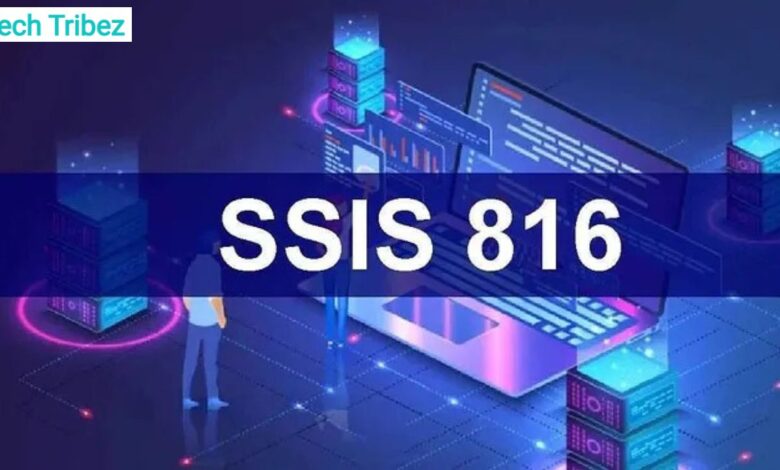Unlocking the Power of SSIS 816: Data Workflow Modernisation for Contemporary Businesses

As for now, people need to deal with a great deal of information in the context of high velocities typical of the contemporary world of digital business. The SSIS 816 (SQL Server Integration Services 816) spearheads data workflow Az audiences to bring the best tools to enable automation, integration, or transforming data across platforms. Using SSIS 816, a business can minimize its operations, which makes the shift from one data process to another faster and less time-consuming than performing those tasks manually. The dashboard is easy to implement and use since it has icons that can be dragged and dropped, unlike other content management systems that are complicated to create from the ground up.
The newest addition to the ranks of SSIS is SSIS 816, which operates in real-time, offers superior performance and processes not only the most common formats but also formats such as XML, which will help businesses deal with huge amounts of data. Moreover, it also supports compatible cloud solutions such as Azure and AWS, enabling organizations to expand their size with no boundaries. It helps businesses to adapt their competitive positions and dynamics because it is an effective means of performing analytical work determined by numerous factors, such as the speed of data processing, free from human errors resulting from fatigue or inaccurate assessment of the situation. This is why, for business managers and analysts of today’s companies seeking increased flexibility, speed, and accuracy in their data management, SSIS 816 represents the way to go.
Why SSIS 816 is a Game-Changer for Data Integration
They have cited data integration as one of the biggest challenges, if not the biggest, of contemporary business processes. Lack of integration allows information to fall between gaps or create channels of work that slow the process down, potentially leading to further loss of important data. With SSIS 816, there is a way of easily transforming and transferring data from many servers without hindrance. Integrating data from various databases into a single system is impossible, which is desirable for businesses when one requires insights into the other’s data. Further, SSIS 816 provides several fortified factors, including the ability to handle errors and automatically produce the log in case of a loss or a mistake resulting from integration.
There is a lot that can be said about Microsoft products’ integration with another in SSIS 816 since it is among the things that make the data integration capability of SSIS stellar. Current Microsoft SQL Server or Azure users will find great value in the extremely close coupling of SSIS 816 capabilities. Additionally, SSIS 816 provides compatibility with formats such as XML, JSON, and CSV; this means that the company can deal with data from different sources in one place. It allows its users to work through an easy-to-operate graphical development environment called SSIS 816, which has the enhanced capability to carry out massive data flows with ease and creates custom business workflows that improve data operations and enhance the rate of decision-making.
What Makes SSIS 816 Different from Other Workflow Tools?

Many vendors offer data integration tools. However, SSIS 816 is exceptional because of its features, operational simplicity, and the possibility of expanding its functionality. In contrast to other tools, SSIS 816 features a compound object, which allows the creation of the most complex workflow diagrams without dragging specific items. This feature makes it easy for non-tech personnel to use and enables various teams to develop incredibly robust data processing systems. Of course, other software solutions like Informatica or Talend are similar to SSISFORMATIONDATA_INTEGRATION regarding capabilities. However, due to SSIS 816 simplicity, businesses of all sizes can easily employ it.
Furthermore, SSIS 816 is associated with robust performance-boosting capabilities, putting it into a powerful package to monitor large real-time data. Other tools may need help to handle large amounts of data similarly, making the SSIS 816 one of the high-performance tools. Moreover, the integration capabilities of SSIS 816 underscore its advantage over rivals: the tool is designed for cloud compatibility with Azure, AWS, and Google Cloud. This leads to the fact that companies can easily migrate from infrastructure localized in the company to cloud solutions without the help of other tools. The amount of customization SSIS 816 brings to the table ensures that businesses across industries and with complex data requirements can implement the solution as it is and not make adjustments.
When Should You Implement SSIS 816 in Your Organization?
It is also important to identify that it signifies that SSIS 816 can help achieve improved results so that potential advantages can be maximized. In most cases, organizations should implement SSIS 816 once the business faces problems like ineffectiveness, redundancy, or unreliable features in data processing. SSIS 816 is most suitable for firms that deal with huge volumes of data or transform data often between various systems. If your company is challenged by the following, SSIS 816 can effectively solve a multitude of data sources, such as reporting generation, manual reporting, and inconsistent data structures.
Moreover, this paper establishes that scaling organizational operations can be facilitated using SSIS 816. This applies whether your organization needs to extend your data collection across other cloud services or if you have to switch out your outdated systems: SSIS 816 has robust compatibility with different platforms. Another primary sign that it is time to implement SSIS 816 is if your business intends to incorporate deeper data-driven decision-making processes, including BI systems or analytics. These sophisticated systems are built upon the wheel of SSIS 816 to provide higher quality integrated and uniform data from other sources.
Why Businesses are Switching to SSIS 816 for Seamless Data Transformation
Today’s businesses are increasingly migrating to SSIS 816 because SSIS software can ensure the successful daily transformation of information. Data transformation is an important step in modern organizations that utilize data from several systems. While loading data from various databases to consolidate them in, for example, a data warehouse, there are numerous difficulties that SSIS 816 provides a set of tools to handle. So many industries still need to stick to old appropriate applications that can work with them, It is very hard for them to integrate different data sources quickly and precisely, but SSIS 816 does it for them.
Besides that, SSIS 816 can also help companies create real-time data integration, where organizations’ systems are updated in real time. It is especially advantageous for financial, medical, and trade organizations as correct and updated information is essential in these fields. Most companies use this software since it is easy to integrate SSIS 816 with other databases or APIs. The capacity to transform data while maintaining integrity guarantees organizations prioritize what concerns them – value and growth using insight.
What are the key features of SSIS 816 that you need to know?
SSIS 816 has several features that ensure it is a decisive platform for data integration and managing business processes. The most notable is the graphical timeline-based workflow creation and management tool, which requires almost no coding. This means that by using Datapacks, it becomes much easier to drag and drop elements and create pipelines in simple ways without hiring the services of developers. SSIS 816 also provides many built-in tools and operations to integrate and transform data, reducing the difficulty of handling numerous source systems.
They include several Precedent constraints, two Catch blocks, and Three level control tasks. This involves the uniqueness of the errors log and report function; errors are logged and highlighted for quick resolution when migrating and integrating data. This helps to ensure that the data has not been corrupted in the process. Also, SSIS 816 provides inclusive compatibility to various data formats and sources like Database, Azure, AWS, and the like for any size of business. Finally, due to the capability of SSIS 816 to handle large volumes of data in the future, the solution will be ideal for any growing business that expects its databases to double or triple in size.
When to Overcome Common Challenges During SSIS 816 Implementation
Although SSIS 816 is a strong tool, working with it can include possible difficulties for organizations that use scripts and data integration tools for the first time. The most frequently encountered challenge is an unclear concept of how to build effective processes. Companies face difficulties regarding data integration, specifically how they pass data from one system to another. To avoid this, more effort by companies should be dedicated to training the staff and then conducting initial tests with the simple pilot projects to ascertain the competency of SSIS 816 in its full implementation.
The fourth challenge is implementing SSIS 816 in existing complex systems, particularly in organizations with aged systems. One must perform adequate testing so that you do not run into problems during the initial setup of the project. Data quality is another widely familiar challenge that organizations grapple with when using big data solutions. When there is a problem with data formats or when datasets are missing important fields, integration becomes a problem, but companies may establish validation rules within SSIS 816 for clean data. A visible tactical plan, effective leadership skills, and consecutive user training are required to address these challenges.
Why Real-Life Success Stories Prove SSIS 816 Efficiency
Many business organizations have benefited from SSIS 816 and have reported increased Efficiency within their organizations. The case that can be discussed as one of the most successful concerns is the large retail chain that used SSIS 816 to address its inventory issues. The real-life integration of the SSIS 816 to the various POS terminals was able to benefit the retailer by allowing for real-time data processing between multiple departments, enhancing the speed of inventory turnover, and the ability to make informed decisions. Customer stock-outs and overstock of certain products were also restricted, thus cutting on unnecessary expenses.
One more good example is the case of one of the financial services organizations that managed to enhance the Efficiency of its reporting by using SSIS 816. Before acquiring SSIS 816, the company needed help consolidating data from numerous systems, and a great deal of time would be required to produce reports. In SSIS 816, they could easily automate data integration tasks, hence minimizing the mistakes generated through manual work on report delivery. Similarly, a healthcare provider implemented SSIS 816 to interconnect patient information throughout different divisions, enhancing data availability and improving patient management quality. It is evident from these real-life examples how effectively SSIS 816 can perform in various domains of industries. Many organizations have reported enhanced operations due to the implementation of SSIS 816. One of the most dramatic examples comes from a large chain store that has successfully adopted its inventory tracking. When the implementation of SSIS 816 linked the point-of-sale systems of the retailer, it could provide real-time data flows between various departments, which helped make quick decisions and enhanced inventory updates. It also helped the company to minimize the consequences of stock shortage and situations when stocks are over, thus cutting costs and improving the whole performance.
Next is the success story of the financial services firm that read this paper to enhance the accuracy of its reports using SSIS 816. As for the key issues before implementing the SSIS 816, one of these was a data integration problem across several systems, which resulted in long delays in producing reports. Through SSIS 816, they could also manage data integration virtually, which minimized most of the errors caused by manual intervention and accelerated the release of reports. Likewise, a healthcare provider applied SSIS 816 to merge the patient details of various departments, which tended to facilitate data accessibility, causing the collection of various patient information, deftly acting as an influential tool to improve the health solutions of those patients. These examples give clear evidence of how flexible and advantageous SSIS 816 can be used in other fields of industry.
What to Expect When Integrating SSIS 816 with Existing Systems
Since SSIS 816 connects to other systems within a business environment, firms should note that if a proper blueprint of how they want the flow and design to be like and adequate testing are there, they should not encounter many difficulties. Another issue favouring SSIS 816 is the flexibility of connectors and adapters, enabling it to integrate with numerous databases, clouds, and 3rd party applications. This flexibility allows businesses to easily connect another layer of their infrastructure to SSIS 816 without fundamentally reshaping their computer programs. Nevertheless, compatibility of SSIS 816 with the current systems will require thorough system testing before implementation.
However, they should also expect certain issues with data consistency when implementing SSIS 816 for businesses. Since the data formats in different systems can be dissimilar, SSIS 816 contemplates validation rules that guarantee that the correct data in the respective platforms are accurate. Moreover, fuelling better system performance and increased efficiency post-integration, SSIS 816 has aspects that replace previous manual processes. From the above points, it is evident that by deploying the systems and then connecting the two systems appropriately, businesses can integrate SSIS 816 into their businesses, hence improving their productivity as well as making the right decisions based on the data they get.
Why SSIS 816 is Crucial for Automating Repetitive Business Tasks

One of the biggest benefits of using SSIS 816 is that it can effectively allocate the tremendous amount of time needed for repetitive business tasks. That is why data extra, action, transformation, and loading,g are often performed manually, even though this could be more effective and faster. SSIS 816 solves this problem by ensuring that these tasks are automated and data is well processed. They minimize the possibility of making mistakes and expedite ETL processing, freeing up business people for significant undertakings.
Performing mundane tasks through SSIS 816 also ensures increased productivity and Efficiency overall. For instance, companies can set SSIS packages to operate at particular frequencies so that data populates immediately as per business needs without involving someone manually in the process. This is particularly helpful for organizations processing big data or as part of organizations in industries that require information as current as possible, such as finance or e-commerce. Moreover, SSIS 816 contains descriptions of task execution, which will contribute to an improved understanding of the business processes and smooth work without interruptions.
When Will SSIS 816 Revolutionize Your Data-Driven Decision-Making?
Through SSIS 816, organizations can improve the ability of the data and analysis to influence decisions, as it will certainly be faster and more accurate. In the case of SSIS 816, it enables the integration of data from several sources with a target, such as a data warehouse. This makes it possible for decision-makers to have access to more real-time, all-round information so that good decisions can be made. Through the enhanced data integration by SSIS 816, managerial decision-making is enhanced in the short run, and organizational planning is enhanced in the long run as heads of corporate teams work with the latest information.
This is where the value of SSIS 816 truly stays because, through the product, it is possible to analyze grade crudes and raw data, yielding valuable insights. It can clean the data, aggregate it, and enrich it to its suitability before it is used for reporting or analysis. This also ensures that only the necessary and credible information is funnelled toward business intelligence tools, thus giving accurate results and strategizing. In particular, as more and more companies set towards the idea of knowledge management, SSIS 816 will perform a growing function of enabling organizations to transform their data into a competitive edge.
Conclusion
SSIS 816 is an excellent tool that drastically changes how organizations approach their data processing. SSIS 816 is highly efficient regarding integration abilities regarding abilities regarding integration abilities aligned with seamless data integration, and the easy-to-use Graphical User Interface suggests that it is a a highly effective solution. When organizations give life to SSIS 816, an organization’s activity can become efficient, there will be a decrease in errors, and the organization’s organization’s hidden potential will be brought to light. Regardless of the complexity of data integration issues that need to be solved or expanding the data warehousing in expanding 816 provides the necessary bandwidth, extensibility, and throughput capabilities. To any organization that dares to look into the future and be competitive in this world dominated by big data, SSIS 816 is not a tool but an asset in your business.
(FAQ’s)
What is SSIS 816, and why is it important?
SSIS 816 (SQL Server Integration Services 816) is innovative and complex data integration software for certain business dimensions, with a spectrum of work automation, change in data formats, and data integration. It is imperative for the trends of modern trade because it makes data management easier, increases productivity, and eliminates the necessity of the manual approach.
How does SSIS 816 differ from previous versions?
Specifically, SSIS 816 provides more improvements than its prior version, including execution in real-time, better integration with cloud environments, and multiple data format support. In addition, it includes a less technical front-end interface that enables users who are not very conversant with designing workflows to design intricate processes.
Can SSIS 816 integrate with cloud platforms like Azure and AWS?
Of course, SSIS 816 works well with the major cloud solutions, including Microsoft Azure, AWS, and Google Cloud, so it’s easier for businesses to scale data processes and manage cloud processes.
What industries benefit the most from SSIS 816?
Thus, SSIS 816 applies to various fields such as finance, retail, healthcare, and e-commerce. The tool is perfect for any industry that processes and analyzes huge amounts of data in real-time.
How does SSIS 816 improve data-driven decision-making?
Using data process automation and the guarantee of real-time data handling, the SSIS 816 makes data timely and relevant for informed decision-making. It results in better and more timely business decisions.
Is SSIS 816 easy to use for non-technical staff?
SSIS 816 has a user-friendly interface similar to a graphic user interface where users can drag items to complete complex tasks. This makes it easy to implement even for non-technical staff since the learning curve is low; hence, its adoption by most organizations is advanced.
What are the main benefits of using SSIS 816 for data management?
SSIS 816 makes work easier because it reduces the time taken for repetitive activities, eliminates human error, consolidates data from different sources, and guarantees up-to-date data. This assists organizations in benefiting from growth and innovation.
Can SSIS 816 handle large datasets?
Absolutely. Due to its high performance in accommodating numerous records, SSIS 816 is suitable for organizations engaged in large-scale data processing, such as financial institutions and e-commerce.
What challenges can businesses face when implementing SSIS 816?
Current problems include Integrating new systems with existing frameworks, improving data quality, and initializing employees. However, as seen above, all these challenges cannot be achieved without adequate planning, training, and testing.
How can businesses get started with SSIS 816?
Firstly, to undertake SSIS 816, it is necessary to analyze the current business processes, define where improvements are needed, and then integrate SSIS 816 into the existing work processes. This should be accompanied by training and support for the staff to develop their full capacity.



